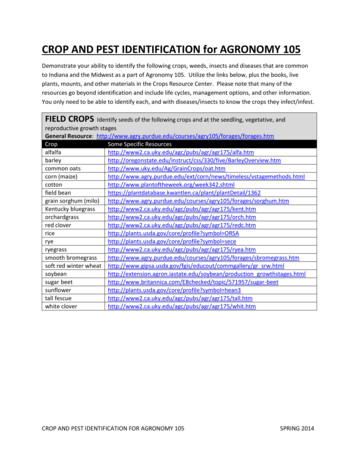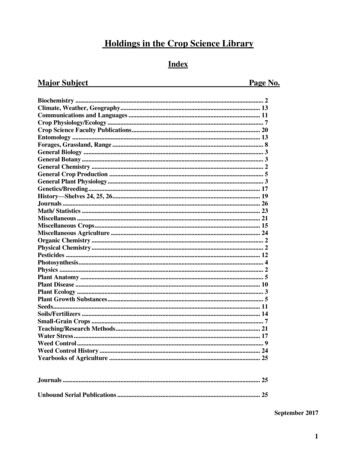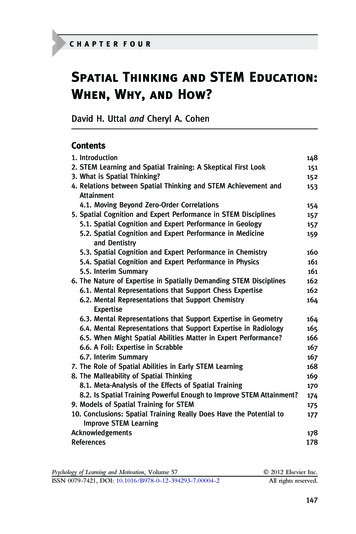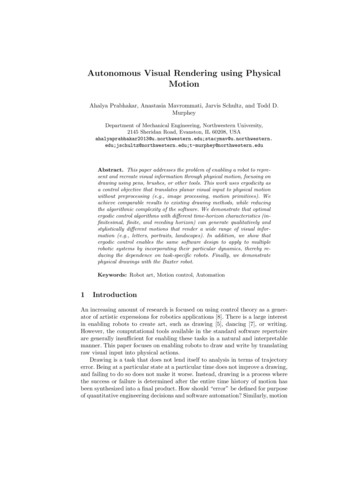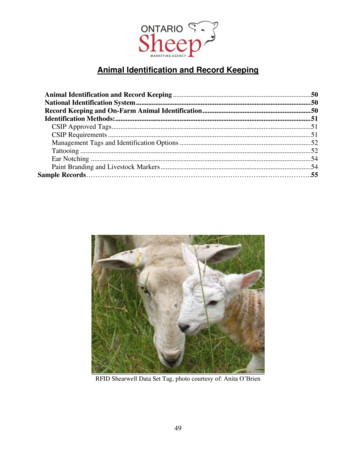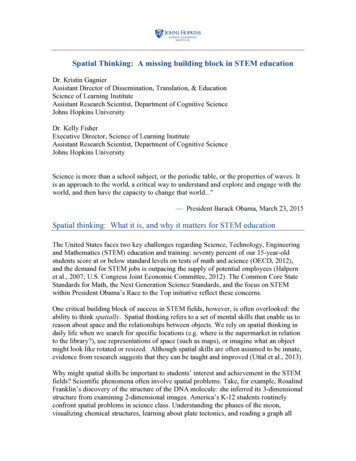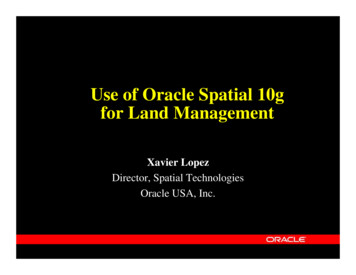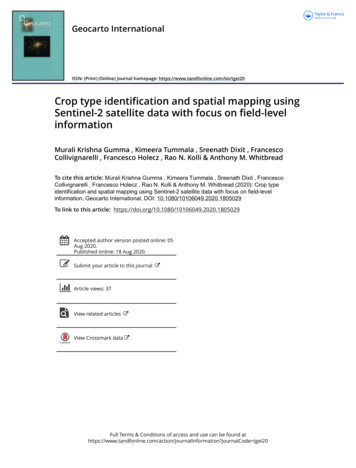
Transcription
Geocarto InternationalISSN: (Print) (Online) Journal homepage: https://www.tandfonline.com/loi/tgei20Crop type identification and spatial mapping usingSentinel-2 satellite data with focus on field-levelinformationMurali Krishna Gumma , Kimeera Tummala , Sreenath Dixit , FrancescoCollivignarelli , Francesco Holecz , Rao N. Kolli & Anthony M. WhitbreadTo cite this article: Murali Krishna Gumma , Kimeera Tummala , Sreenath Dixit , FrancescoCollivignarelli , Francesco Holecz , Rao N. Kolli & Anthony M. Whitbread (2020): Crop typeidentification and spatial mapping using Sentinel-2 satellite data with focus on field-levelinformation, Geocarto International, DOI: 10.1080/10106049.2020.1805029To link to this article: ted author version posted online: 05Aug 2020.Published online: 18 Aug 2020.Submit your article to this journalArticle views: 37View related articlesView Crossmark dataFull Terms & Conditions of access and use can be found ation?journalCode tgei20
GEOCARTO .1805029Crop type identification and spatial mapping usingSentinel-2 satellite data with focus on field-levelinformationMurali Krishna Gummaa , Kimeera Tummalaa, Sreenath Dixita ,Francesco Collivignarellib , Francesco Holeczb, Rao N. KollicandAnthony M. WhitbreaddaRS/GIS Lab, Innovation Systems for the Drylands, International Crops Research Institute for theSemi-Arid Tropics (ICRISAT), Patancheru, India; bsarmap, Caslano, Switzerland; cInternationalReinsurance and Insurance Consultancy and Broking Services Pvt. Ltd, Mumbai, India; dInternationalCrops Research Institute for the Semi-Arid Tropics (ICRISAT), TanzaniaABSTRACTARTICLE HISTORYAccurate monitoring of croplands helps in making decisions (forinsurance claims, crop management and contingency plans) atthe macro-level, especially in drylands where variability in cropping is very high owing to erratic weather conditions. Drylandcereals and grain legumes are key to ensuring the food and nutritional security of a large number of vulnerable populations livingin the drylands. Reliable information on area cultivated to suchcrops forms part of the national accounting of food productionand supply in many Asian countries, many of which are employing remote sensing tools to improve the accuracy of assessmentsof cultivated areas. This paper assesses the capabilities and limitations of mapping cultivated areas in the Rabi (winter) season andcorresponding cropping patterns in three districts characterizedby small-plot agriculture. The study used Sentinel-2 NormalizedDifference Vegetation Index (NDVI) 15-day time-series at 10 mresolution by employing a Spectral Matching Technique (SMT)approach. The use of SMT is based on the well-studied relationship between temporal NDVI signatures and crop phenology. Therabi season in India, dominated by non-rainy days, is best suitedfor the application of this method, as persistent cloud cover willhamper the availability of images necessary to generate clearlydifferentiating temporal signatures. Our study showed that thetemporal signatures of wheat, chickpea and mustard are easilydistinguishable, enabling an overall accuracy of 84%, with wheatand mustard achieving 86% and 94% accuracies, respectively. Themost significant misclassifications were in irrigated areas for mustard and wheat, in small-plot mustard fields covered by trees andin fragmented chickpea areas. A comparison of district-wisenational crop statistics and those obtained from this studyrevealed a correlation of 96%.Received 11 April 2020Accepted 29 July 2020CONTACT Murali Krishna Gummam.gumma@cgiar.org; gummamk@gmail.comß 2020 Informa UK Limited, trading as Taylor & Francis GroupKEYWORDSCropping pattern; Sentinel2; matching technique;small-plot agriculture; semiarid–conditions
2M. K. GUMMA ET AL.1. IntroductionDryland agriculture covers about 68% of India’s total cropland area, characterized bylower mean annual rainfall compared to potential evaporation. Dryland areas are highlyvulnerable because of high variability in rainfall. Forty percent of the rural populationand 60% of the livestock population directly depend on dryland agriculture (Singh et al.2004; Misra et al. 2010). The changing character and extent of dryland agriculture overthe years underlines the importance of monitoring croplands continuously to ensure sustainable food production. Information on district-level cropland extent and statistics areimportant for decision making, not only with regard to issues concerning sustainable agriculture and food security, but also on crop insurance.Crop area statistics collected by different government organizations (departments ofdistrict revenue, agriculture and irrigation) generally show deviations of up to 30% anddon’t truly correspond to the effective seasonal cultivated area (Van Genderen et al. 1978;Stehman et al. 2003; Gallego 2004; Biggs et al. 2006). Satellite images provide a valid alternative, particularly when the area needs to be estimated at the state or national level(Thiruvengadachari and Sakthivadivel 1997; Lobell et al. 2003; Thenkabail et al. 2010).Studies carried out in the past decades, based mainly on coarse resolution data such asAdvanced Very High Resolution Radiometer (AVHRR) and Moderate Resolution ImagingSpectroradiometer (MODIS), demonstrated that cropland extent derived from time-seriesdata has higher accuracy than a single-date image (G omez et al. 2016; Teluguntla et al.2017; Xiong, Thenkabail, Gumma, et al. 2017; Xu et al. 2018). Studies based on Landsat-8and Sentinel-2 single-date images have shown the advantages of moderate resolutionimages for crop mapping, particularly by exploiting object-based methods (Walker andBlaschke 2008; Pe na-Barrag an et al. 2011; Petitjean et al. 2012; Long et al. 2013; Mattonet al. 2015; Belgiu and Csillik 2018) and the region merging approach (Moscheniet al. 1998).The utility of Sentinel-2 data for agricultural applications, and specifically crop typemapping, has been evaluated by many researchers. European Space Agency’s sen2agri(Sentinel-2 for agriculture) project generates a crop type map with 4-5 main crops of theregion at 10 m spatial resolution using the Random Forest-based methodology proposedby Inglada J et al (Inglada et al. 2015). Vijayasekaran (Vijayasekaran 2019) assessed thesen2agri products for the Indian agricultural scenario and reported an overall classification accuracy of 70% on an average for various crops.In recent times, machine-learning algorithms like Random Forest (RF), Support VectorMachines (SVM), and Artificial Neural Networks (ANN) have been used by researchersto classify satellite data and its derivatives into crop types. Saini et al. (Saini and Ghosh2018) performed crop classification on a single-date Sentinel-2 image using RF and SVMalgorithms. Sun C et al. used a combination of spectral bands, derived textural measures,and vegetation indices from Sentinel-1 SAR, Sentinel-2 optical and Landsat-8 optical datasets to perform crop classification using machine-learning methods SVM, ANN, and RF(Sun et al. 2019). More similarly, Feng (Feng et al. 2019)used Sentinel-2 time-series dataalone for mapping crop types. They successfully used spectral bands, texture parameters,vegetation indices, and phenological parameters derived from Sentinel-2 time-series dataas inputs to RF and SVM classification algorithms. They examined the use of short-waveinfra-red (SWIR) and water vapour bands of Sentinel-2 data for differentiatingbetween crops.Li Q et al. applied a maximum likelihood classifier on a combination of Landsat TM30 m resolution data and features related to crop growth extracted from MODIS NDVItime-series data (Li et al. 2014). Belgiu M and Csilik O performed both object- and pixel-
GEOCARTO INTERNATIONAL3based classification using time-weighted dynamic time warping and RF analyses onSentinel-2 time series NDVI images (Belgiu and Csillik 2018). Griffiths P et al. integratedSentinel-2 and Landsat-8 data to generate an intra-annual time-series composite of tendays to generate a national level crop-type map of Germany using Random Forest classification algorithm (Griffiths et al. 2019).Many studies have applied SMTs on optical data to obtain information on differentland uses and land covers (LULC) (Thenkabail et al. 2007, Gumma et al. 2016, Gumma,Thenkabail, Teluguntla et al. 2018). Thenkabail et al. used SMTs to map historical LULCand irrigated areas using time-series AVHRR pathfinder datasets for the Krishna RiverBasin, India. Gumma et al. (2011) applied SMTs to map rice ecosystems in South Asia for2000-01 using MODIS NDVI monthly maximum value composite (MVC) data; to monitor the spatial expansion of chickpea (Gumma et al. 2016) and to differentiate betweencanal and groundwater irrigation areas in the Krishna River basin using MODIS 250 mdata (Gumma et al. 2011). Recently, studies using MODIS NDVI time-series have beenreported on mapping rice-fallows for crop intensification using short duration legumesemploying NDVI time- series data (Gray et al. 2014, Gumma, Thenkabail, Deevi, et al.2018), and mapping drought prone areas across India (Gumma et al. 2019). Coarse resolution data were found to be effective in estimating the extent of homogeneous land coverareas, but failed to accurately estimate the area, particularly in small-plot agriculture(Gumma et al. 2014).In the present study, an attempt was made to apply the SMT using high-resolution(10 m) satellite data at district-level. The focus was on crop type mapping with crop insurance and crop yield modeling as the major consumption areas. With rising emphasis oncrop insurance in India, it has become imperative for the stakeholders to have access tothe spatial information of crop type, crop health and stress at field level. This informationalso needs to be available for large areas (districts or states), and include informationabout all crops grown in those areas. The presence of a wide variety of crops in a smallarea has always posed difficulties in capturing the complete spatial variability of crops inthe drylands of India. In the present study, these drawbacks have been focused on, andimprovements have been made to field data collection, data processing including qualitycheck, and spectral matching techniques for classification, in order to obtain the bestresults for the particular concerns mentioned above. The classification results for rabi season of 2018-19 in three dryland districts of India – Jhansi, Chitrakoot and Panna – werestudied. The results were validated against ground validation points and area statisticsprovided by state agriculture departments. A part of a larger study, this study discussesthe advantages and shortcomings of using optical data (Sentinel-2; 10 m spatial resolution)for crop type mapping in particular.2. Study area and data2.1. Study areaThe three study districts of Jhansi, Chitrakoot and Panna are located in Bundelkhandregion in India (Figure 1) that lies between 230500 N and 260000 N latitudes and 780000 Eand 820000 E longitudes. Bundelkhand, spread across the states of Uttar Pradesh andMadhya Pradesh, is subject to a dry sub-humid and semi-arid climate. Jhansi district islocated in western Uttar Pradesh that spans 5,024 km2, with a population of about 1.998million with a density of about 400/km2. The district lies in the plains region ofBundelkhand, and thus, has a larger area (70% of the total area) under cultivation. This
4M. K. GUMMA ET AL.Figure 1. Study districts with location map showing climate zones. (www.FAO.org).region is distinguished for its deep black soil, known as ‘mar’, and is very well suited forcotton cultivation. Chitrakoot district covers 3,216 km2 and has a population density ofabout 310/km2. The district lies in the intermediate region of Bundelkhand, which has ahigher percentage of wasteland compared to the plains region. Consequently, only about50% of the total area of the district is under cultivation. Panna district covers an area of7,135 km2, and has a population density of 140/km2. Of the three districts, Panna has thehighest percentage of wasteland and consequently, only 35% of its total area is undercultivation.The size of landholdings not only affects agricultural production, but also determinesthe accuracy of spatial maps generated from satellite data. High variability in crops andsmall landholdings make it necessary to use satellite data of high spatial resolution thatcan capture the variability. In Jhansi and Chitrakoot districts, about 20% of the total cultivated area is under marginal landholdings (less than 1 ha) and in Panna district it is 11%.Small holdings (1-2 ha) constitute 22% of the cultivated area in Jhansi district, 21% inChitrakoot district and 22% in Panna district. Most of the landholdings in the three districts are semi-medium (2-4 ha) and medium (4-10 ha) in size. Fifty-four percent of thecultivated area in Jhansi district, 46% in Chitrakoot district and 58% in Panna district arecomprised of landholdings that are 2-10 ha in size (Agriculture Census Input Survey2001-02). Sentinel-2 data with 10 m spatial resolution was chosen to map the small to
GEOCARTO INTERNATIONAL5medium size agricultural plots, which form the majority of the crop area in the threestudy districts.In Jhansi and Chitrakoot districts, the percentage of land under irrigation is lower thanthe state average for Uttar Pradesh. About 48% of sown area in Jhansi and about 28% inChitrakoot is irrigated. In Panna, about 28% of sown area is irrigated (District-wise LandUse Statistics, Ministry of Agriculture, Government of India, May 2008). In all the threedistricts, more land is cultivated during rabi season than kharif season, owing to the availability of residual moisture and climatic conditions that are conducive to crop growth. InJhansi district, the major rabi crop is wheat, followed by chickpea, peas and beans, andlentil. Mustard and barley are also cultivated in some areas. In Chitrakoot district, wheatand chickpea are cultivated in most areas during rabi season, followed by lentil. Barley,mustard, linseed, and peas and beans are found in small areas. In Panna district, chickpeais the major crop, followed by wheat, peas and beans. This district also has lentil, andsmall areas with mustard and linseed.2.2. Sentinel-2 dataSentinel-2 10 m resolution with 6-day surface reflectance from the EU CopernicusProgramme is ideal for monitoring vegetation at a small scale (Xiong, Thenkabail, Tilton,et al. 2017). In this study, we used Sentinel-2 products, which provide 6-day compositeimages at 10 m spatial resolution (bands 2, 3, 4 and 8). Sentinel-2 products include blue,green, red, near infrared and mid-infrared bands. Four tiles covering the required regionwere downloaded from the Copernicus Open Access Hub (https://scihub.copernicus.eu/).MAPScape was used to pre-process and mosaic the tiles of the study area, and then stackthem as a single composite. Cloud contamination can be severe spanning several consecutive 6-day composites, especially during early rabi seasons (October to January). We choseto address this by generating fortnightly (FN) composites and for use in conjunction withthe 6-day composites. Each pixel in the Sentinel-2 dataset contains the best observationduring the 15-day period that it covers. The data are described in greater detail in theScientific Data set documentation for Sentinel-2 (Xiong, Thenkabail, Tilton, et al. 2017).3. Methods and approaches3.1. Ground survey dataGround data were collected during 7–31 January 2019 for 732 sample points coveringabout 4000 km of road travel in the study districts (Figure 2, Table 1). Ground data werecollected based on pre-classified output and Google Earth imagery, and a tracking GPSattached to image-processing software captured ground survey information while movingon the road. Detailed information certain locations were collected for training, i.e., classidentification and labelling. Point-specific information was collected from 90 m 90 mplots and consisted of GPS locations, land use categories, land cover percentages, croppingpattern during different seasons (through farmer interviews), crop types and wateringmethod (irrigated, rainfed). For validation, information on crop type and point coordinates (latitude and longitude values) were only collected at point locations. Samples wereobtained within large contiguous areas of a particular LULC. Sentinel-2 False colourComposites were used as additional ground survey information in class identification. Astratified-systematic sample design was adopted based on road network or footpath access.Where possible, sample sites were systematically located every 5 or 10 kilometres along
6M. K. GUMMA ET AL.Figure 2. Ground survey data for different crops and spatial distribution of samples for training and validation.Table 1. Number of training and validation samples collected for training data of each class identificationand validation.Jhansi ground truth informationSample classTrainingValidation01. Wheat02. Chickpea03. Mustard/ beans04. Wheat/mustard/chickpea05. Pea beans06. Other LULCTotal681613199151407911111024117Chitrakoot ground truth informationSample class01. Wheat02. Chickpea03. Mustard/lentil04. Wheat/mustard/chickpea/lentil05. Other crops06. Fallow/ mixed crops07. Other 116Panna ground truth informationSample class01. Wheat02. Chickpea03. Wheat/ mustard/ lentil04. Fallow/ other crops05. Other LULCTotalTraining53719916104Validation991933711169
GEOCARTO INTERNATIONAL7the road network by vehicle or on foot (Thenkabail et al. 2004; 2005), which is detailed ina description of the ground survey methodological approach.We collected two independent data sets, one for training and another for validation.Table 1 shows sample size of training data for classification and validation data for accuracy assessment in each district.3.2. Ideal NDVI temporal signaturesA prerequisite for employing SMT is to identify ideal NDVI temporal signatures for eachclass of interest. In this case, Sentinel-2 time-series and ground survey data collected fromhomogeneous patches along with in-depth information about the cropping system andirrigation methods were used to generate ideal temporal NDVI signatures. The ideal spectra for four major crops of Jhansi district – wheat, chickpea, peas/beans and mustard –are shown in Figure 3. In the spectra, the beginning of the rising spectral profile marksthe germination. From Figure 3, it is evident that the germination time for wheat is midDecember, for chickpea it is mid-November, for peas/beans mid-November and for mustard early-mid November. The peak biomass period (peak of season) occurs in mid-lateMarch in wheat, late December in chickpea, late January-early February in peas/beansand late January in mustard. Leaf senescence (end of season) can be observed in April inwheat, February in chickpea and March in peas/beans and mustard. These differentiatingspectral characteristics were taken advantage of for separating various crops.3.3. Seasonal cultivated areaFigure 4 provides an overview of the methodology used for mapping the rabi cropping pattern.MAPscape-Basic software, which supports the processing of Landsat, Sentinel-2 andMODIS data and spaceborne Synthetic Aperture Radar data, was used to automaticallydownload and generate time-series of various indices related to vegetation, bare soil,built-up, and water at a resolution of either 10 m or 20 m.Sentinel-2 data for rabi cropping season, i.e., for the months of January, February andMarch, for the year 2019, was considered for the present analysis. The 15-day MVCs ofNDVI were generated and stacked using functions supported by MAPscape-Basic. The Kmeans classifier was applied on the NDVI MVC time-series stack to generate clusters ofsimilar pixels belonging to 70 classes. The NDVI MVC time-series spectra of these classes,known as class spectra, were plotted and compared. Classes with similar spectra weregrouped using spectral similarity values (SSVs). The lower the SSV, the higher the similarity between the two classes. The classes were then identified and labelled using SMT(Gumma et al. 2014).Intensive ground data were used for class identification. The ideal NDVI MVC spectrafor each crop type were established based on 113 unique samples selected from theground survey data. These samples were selected to effectively represent all major croptypes, and in homogeneous areas that are large enough to avoid confusion while determining the crop type using the time-series spectra. For each class, the ideal spectra weretaken to be the average of the spectra of all locations belonging to that class. The classspectra were compared with the ideal spectra and labelled with the land use of the matching spectra. For this step, ground reference data and Google Earth images were used toimprove class identification.
8M. K. GUMMA ET AL.Figure 3. Ideal temporal profiles of NDVI for various crops (top); and temporal profiles of NDVI values from random locations.3.4. Seasonal cultivated area validationAccuracy assessment was performed based on the validation data. A total of 402 groundsurvey samples (Panna ¼ 169, Chitrakoot ¼ 116 and Jhansi ¼ 117) were used to assessthe accuracy of the classification results, based on a theoretical description given byJensen (Jensen 2004), to generate a confusion matrix. The columns of a confusionmatrix contain the field-plot data points, and the rows represent the results of the classified crop maps (Congalton 1991). Accuracy measure is Kappa, producer, user and overall accuracy (Cohen 1960), representing the agreement among user and referenceground survey data.
GEOCARTO INTERNATIONAL9Figure 4. Workflow for rabi crop classification.3.5. Comparison with regional statisticsThis study generated crop type maps for the three study districts. Area statistics wereextracted from crop type maps. District-wise maps were tested for accuracy using fieldplot data collected by the research team, and national statistical data obtained from government agencies. Areas generated from the present study were compared with the areastatistics available to us from the National Statistics report (http://aps.dac.gov.in/APY/Public Report1.aspx).
10M. K. GUMMA ET AL.Figure 5. Spatial distribution of rabi crops along with other LULC for the three districts (a) Jhansi, (b) Chitrakoot, and(c) Panna.4. Results and discussion4.1. Crop patternsWheat occupied the largest cropped area followed by chickpea in all three districts. InJhansi district, wheat dominated almost the entire area except the north-eastern part,which was dominated by chickpea. Mustard was mainly concentrated in the northern partof Jhansi district (Figure 5a). Out of the 280,000 ha sown (56% of the total geographicalarea of the district) in Jhansi district, wheat occupied about 64.2%, chickpea around13.5% and mustard about 6.6% (Table 2a).The southern part of Chitrakoot district is dominated by forest, shrub and grasslands,with a few small pockets of cultivated land. The northern part of the district, which ismainly cultivated land, is dominated by wheat, followed by chickpea and mustard. All thethree crops are distributed throughout the northern part of the district (Figure 5b). Table2b shows the crop area statistics for Chitrakoot district. A total of 130,000 ha (40% of thetotal geographical area of the district) was cropped in the district in rabi 2018-19, out ofwhich about 38% was wheat, 12.6% chickpea and 11% mustard. Lentil is another cropthat was found in small areas in Chitrakoot district.Panna district, like Chitrakoot district, has large areas under forest, shrubs and grasslands. The central and northern patches have major agricultural lands, which were dominated by wheat and chickpea. Peas/beans and lentil were also cultivated in small areas(Figure 5c). Crop area statistics for Panna (Table 2c) showed that about 300,000 ha (41%of the total geographic area of the district) was under cultivation during the season, outof which about 40% was under wheat and 27.4% under chickpea.The exploitation of SMT on Sentinel-2 NDVI time-series allowed the provision offield-level information with clear field boundaries, which is important in the agriculturalscenario of Bundelkhand, where about 60% of the agricultural plots are less than 2 ha insize. As illustrated in Figure 6, the Sentinel-2 False Colour Composite (FCC) image andthe corresponding classified image are shown for a part of Jhansi district. Temporal
GEOCARTO INTERNATIONAL11Table 2. Rabi crop area in hectares.JhansiCrop categoriesArea eaPeas/mustardOther classesWater bodiesChitrakootCrop categoriesArea /chickpeaOther cropsFallow/mixed cropsOther classesWater bodiesPannaCrop categoriesArea 542WheatChickpeaPeas & beans/lentil/wheatFallow/other cropsOther classesWater bodies /wetlands/fallowFigure 6. Spatial distribution of rabi crops at plot level (top) and the plot-wise spectralprofiles for wheat, chickpeaand mustard (bottom).
12M. K. GUMMA ET AL.Table 3. Overall accuracy with producer’s accuracy and Kappa coefficient of three districts for rabi crop area maps.JhansiLULC Class01. Wheat02. Chickpea03.Mustard04. Wheat/mustard/chickpea05. Peas/mustard06. Other LULCUser’s accuracyProducer’s accuracyKappa 700.501.000.64User’s accuracyProducer’s accuracyKappa 351.001.001.001.000.77User’s accuracyProducer’s accuracyKappa 860.74ChitrakootLULC t/lentil/chickpea/mustardOther cropsFallow/mixed cropsOther LULCPannaLULC mustardFallows/other cropsOthers LULCNDVI profiles for the three fields in the area, one each of wheat, chickpea and mustard,showed how the differences in the profiles of different crops were used to classify croppedareas into crop types.4.2. Accuracy assessmentTable 3shows user’s and producer’s accuracy for each crop in the three study districts. Itwas performed independently with 404 validation sample points (Jhansi ¼ 121, Chitrakoot¼ 116 and Panna ¼ 167). Overall accuracy for all three districts was 84% and the Kappacoefficient was 0.72 (accuracy for Jhansi was 83%, for Chitrakoot 82% and for Panna 86%).Producer’s accuracy for Jhansi district cropland map was 68% and user’s accuracy was 81%.Accuracies varied based on crop homogeneity, with wheat having the highest spatial extentof 388,717 ha (55% of total cropped area), and correspondingly, the highest accuracy amongall the classes. Producer’s accuracies for wheat class were 95% for Jhansi and Chitrakootdistricts and 85% for Panna district. Total accuracy for wheat crop over all three districtswas 92% (8% error of omission). Chickpea occupied the highest area after wheat, with anarea of 134,914 ha (19% of total cropped area). Overall accuracy for chickpea crop was 70%(with 30% error of omission), which is lower than that for wheat, because chickpea crop isheterogeneous (fragmented fields). Overall accuracy for mustard crop was 58%, which alsohas much less spatial extent with 61,713 ha (9% of total cropped areas). Table 3 shows theoverall Kappa coefficients for the three study districts.4.3. Significance of Sentinel-2 time-series for crop type mappingCrop classification based on Sentinel-2 NDVI 15-day time-series exploiting SMT was successful in differentiating cropping patterns in wheat, chickpea, mustard and beans, which
GEOCARTO INTERNATIONAL13Figure 7. Crop area statistics derived from Sentinel-2 compared with NAS (national agriculture statistics) data formajor crops in Jhansi, Panna and Chitrakoot districts.had not been done in earlier methods. This methodology could correctly classify wheat,chickpea and mustard crops in the dryland areas, where a clear difference between temporal signatures of different crops was identified for the rabi season (Figure 4). However,some areas were mixed due to intercropping pattern in the eastern part of Jhansi (Figure6). Also, other minor cropped areas with high tree cover percentage were often misclassified as shrub lands and minor fragmented cropped areas mainly in the high altitudeswhere beans and mustard were the major crops contributing to most of the inaccuracy.Existing studies show that Sentinel-2 data is sufficient for crop-type mapping providedregular temporal availability during the crop season. They also show that machine-learning techniques like RF, SVM, and ANN are highly efficient in crop type classification.However, these methods have not been successful in mapping crop types in small, fragmented fields and fields with inter-cropping. This paper proposes a scalable classificationmethodology that is efficient for crop type mapping in areas with small, fragmented andmultiple crop types, which dominate the drylands of South Asia and Africa.The results obtained were compared with national statistics district-wise and there wasvery good correlation (Figure 7).To improve accuracy, further work is needed with Hyperspectral images (ex:Hyperion) and Sentinel-1 (SAR data) in fusion with Sentinel-2 time-series datasets (10 mspatial resolution). This will minimize the spectral and spatio-temporal resolution, andprovide an ideal platform for mapping specific crops such as wheat, chickpea, and othermajor crops with high intensity (i.e., grown during more than one season in one year).4.4. Utilization of high resolution maps for yield assessment and insuranceHigh spatial resolution crop type m
Crop type identification and spatial mapping using Sentinel-2 satellite data with focus on field-level information Murali Krishna Gummaa, Kimeera Tummalaa, Sreenath Dixita, Francesco Collivignarellib, Francesco Holeczb, Rao N. Kollic and Anthony M. Whitbreadd aRS/GIS Lab, Innovation Systems for the Dry
